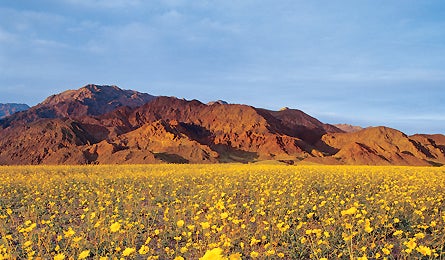Natural Wonders: Death Valley's Wildflowers

'(Photo by Chuck Haney)'
Natural Wonders: Death Valley’s Wildflowers |
Natural Wonders: America’s Smallest Deer |
Natural Wonders: Colorado’s Tallest Frozen Waterfall |
The Wonder
During the first two weeks of March, blooms here can blanket several hundred acres with colors like sunshine-yellow desert gold and violet-and-red desert fivespot. And that’s in an average year. Keep an eye on winter rain: Consistent moisture throughout fall and winter (as opposed to intense, isolated downpours) is more effective in breaking through the tough coating that enables some wildflower seeds to lay dormant for decades. Under optimal conditions, blooms can exceed 100,000 acres.
The Way
No matter what season, canyons hold more moisture. Park at the Titus Canyon Mouth parking area to access a six-mile out-and-back into Fall Canyon, a shady slot that nourishes notch-leaf phacelias and endemic Death Valley sage. Go north along the base of the mountains for .5 mile, then turn into the mouth. Hike another 2.5 winding miles through the crevice to a 35-foot dry falls (scramble the right side to access narrows beyond). Find daily bloom updates at nps.gov/deva/planyourvisit.